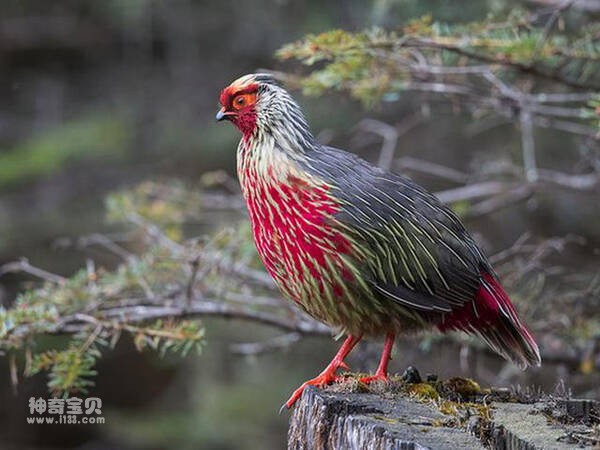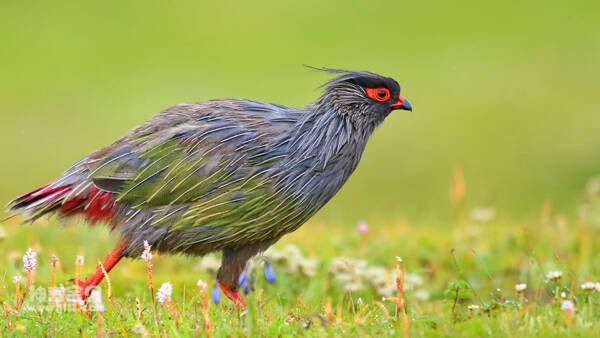Ithaginis cruentus
IUCN
LCBasic Information
Scientific classification
- name:Ithaginis cruentus
- Scientific Name:Songhua chicken, Taibai chicken, blood chicken, bush chicken, green chicken, willow chicken,Ithaginis cruentus,Blood Pheasant
- Outline:Landfowl
- Family:Galliformes Phasianidae Haematopheasant
Vital signs
- length:37.5-47cm
- Weight:45-610g
- lifetime:8-12years
Feature
Strong character, born with a stubborn temper
Distribution and Habitat
The world is distributed in the Himalayas such as Nepal and Sikkim, as well as in northwestern Myanmar.
In China, it is distributed in Tibet and Sichuan, south to northwestern Yunnan, north to the Qilian Mountains in Qinghai and Gansu, and Qinling Mountains in southern Shaanxi.
The blood pheasant is a high-cold mountain forest and shrub pheasant, living in alpine coniferous forests, mixed forests and rhododendron shrubs near the snow line, with an altitude of 1700-3000 meters. There is an obvious seasonal vertical migration phenomenon. In summer, it can sometimes reach the alpine shrub areas at an altitude of 3500-4500 meters. In winter, it mostly hibernates in the middle and low mountains and subalpine areas at an altitude of 2000-3000 meters. Birch, red birch, mountain poplar, mountain willow, fir and arrow bamboo are the main tree species in the typical habitat.
Appearance
Male bird: The forehead, eye ridge, eyebrow lines and cheeks are black, with some crimson color except the eye ridge. The top of the head is earthy gray, the feather rachis is gray-white, and some feathers extend backward to form the crown feathers; the sides of the back of the head are dark brown; the ear feathers are also dark brown, with white feather rachis patterns, and extend backward to form the crown with the extended feathers on the top of the head; the neck Light earthy grey, with wide white feathers; the back to the upper tail coverts are dark brown, with white feathers; the longest upper tail coverts have crimson edges, the small coverts on the wings and the shorter middle coverts are The back is the same color, the longer middle coverts and large coverts are mostly brown, with white feather shaft stripes with black edges and wide green end spots; the primary and secondary flight feathers are dark brown with white shaft stripes; the outer sides The outer soles of the second
Details
Blood Pheasant is called Blood Pheasant in foreign language, and has 12 subspecies. Also known as Blood Chicken and Songhua Chicken, the male Blood Pheasant has red large coverts, undertail coverts, uppertail coverts, feet, head sides, and wax membrane, so it is called Blood Pheasant. It has many aliases, which are different in different places. In Gansu, because its chest and wing coverts are stained green, it is called "Green Chicken"; because its feathers are shaped like willow leaves and are stained green, it is also called "Willow Chicken"; because it mainly lives in pine and spruce forests and eats pine (fir) leaves and seeds, it is also called "Grouse Seed"; and because its feet are red, the most common name is "Red-footed Chicken".

Blood pheasants like to live in groups, often in groups of a few to dozens. Usually they start to move at dawn and continue until dusk, often resting on rocks or in the shade of trees at noon. They mainly move on the ground under the forest and roost in trees at night. Male birds often serve as guards during activities. When in danger, the male birds serving as guards often make a rapid "si-" sound, and the other individuals immediately hide in the grass or bushes under the forest after hearing the sound. Generally, they do not take off, and mainly escape from enemies by running quickly and hiding.
Blood pheasants migrate vertically with the seasons. They usually start to move at dawn and do not fly to the lower branches of pine and fir trees until after dusk. At noon, they take a short rest under rocks or in the shade of trees.
The food of blood pheasants is mainly plants. More than 90 species have been recorded. They often peck at food with their beaks, eat while walking, and peck very quickly, but rarely use their feet and beaks to dig food. The types of food vary with the seasons. In winter and spring, they feed on young leaves, buds, and inflorescences of various trees such as poplar, birch, pine, fir, sumac, and linden. In summer and autumn, they mainly feed on young branches, leaves, berries, and seeds of shrubs such as honeysuckle, elaeagnus, pods, roses, stone pods, raspberries, and buttercups, as well as mosses and lichens. Insects such as lepidoptera larvae, grasshoppers, and golden flower beetles, as well as more than 10 small invertebrate foods such as centipedes and spiders, were also recorded.

Male birds make short si calls and cluck when they are warning. Sometimes several si whistles are connected to form a sisisi sound. Both male and female birds make kite-like chiu-chiu screams to summon scattered birds.
The breeding season of blood pheasants is from late April to June, with slight differences depending on the region and distribution altitude. They are monogamous. Usually, the group disperses in late March and early April, and courtship and mate struggles occur. Often, two male birds peck each other head to head until the loser flees and the winner pairs with the female. Unmarried male birds wander in small groups of 3-5.
Female birds begin to lay eggs in early May. They find a hidden depression in the bushes, under rocks, or next to a large fallen tree in the forest, grab or peck some fallen leaves, mosses, pine needles, wormwood and fine roots together, and press them with their bodies to make a loose nest. The nest is built in a tree hole at the base of a fir tree, with dry leaves spread on dead branches, and covered with its own feathers. The nest is shallow and disc-shaped, with an outer diameter of 19-27×20-24 cm, an inner diameter of 13-21 cm, and a depth of 4-8 cm. The nest mouth faces the sun and is well lit. After building the nest, it begins to lay eggs, one egg every 2-3 days, and a full nest of about 3-9 eggs. The eggs are light yellow, with many dark ochre or dark brown spots of different sizes and shapes and smaller dark fine lines. After each egg laying, the female bird often lies quietly in the nest for about 30 minutes before leaving the nest to forage with the male bird, but generally does not leave the nest area. After the last egg is laid, the female bird begins to incubate the eggs, which are undertaken by the female bird. The male bird moves around the nest during the day and is responsible for guarding the nest, and roosts on a tree near the nest at night. The female bird is very attached to the nest during the incubation period, especially in the late incubation period. She often does not leave the nest even when people come to the nest, and sometimes she will not leave the nest even if she is driven away by branches. Before the female bird goes out to find food, she always covers the eggs with some dead grass leaves or feathers to hide the eggs. The place where she finds food is not far from the nest, about 100 meters away.

According to measurements, when the female bird left the nest, the surface temperature of the eggshell was 24.5-28℃, the temperature at the bottom of the nest was 19.5℃, while the air temperature was 9℃ and the relative humidity was 71%. During the female bird's incubation period, the male bird moved and patrolled in the area around the nest to prevent other birds of the same species from entering the nest area, showing a strong nest protection behavior. Sometimes it also came to the edge of the nest and had a close relationship with the female bird. After 28-29 days of incubation, the chicks hatched. The newly hatched chicks weigh about 19 grams, with a beak length of 8 mm and a tarsus length of 21 mm. They are covered with brown down feathers, with light yellow forehead and sides of the head, a dense black crown on the top of the head extending to the back of the neck, dark brown eye circles, back eye patterns and ear feathers, and dark brown spots in the center of the back. The beak and feet are flesh-red, which looks very cute. After the down feathers are dried the next day, they will leave the nest with their parents and live a wandering life. If they encounter danger, they can quickly drill into the earth hole and hide in the grass until the danger is over and they hear the call of the parent bird, then they will drill out from the hiding place. This wonderful instinct can protect them from natural enemies.
In April-May 1984, a survey of Pingwu, Sichuan and Taibai Mountain, Shaanxi showed that the average population density in Wanglang Nature Reserve in Pingwu, Sichuan was 0.66 per hectare, and the population density in Taibai Mountain Nature Reserve in Shaanxi was 0.1-0.13 pairs per hectare, with a minimum of 5 pairs. In 1981, a survey in Qilian Mountain, Qinghai showed that the average population density was 0.04 per hectare in summer and 0.06 per hectare in winter. In a survey in Qilian Mountain, Gansu from May to June 1984, the average population density was 0.17 per hectare. The population size in various places is extremely unbalanced, with the population density in the two reserves being higher, which shows that establishing nature reserves is one of the effective ways to protect blood pheasants.
Listed in CITES Endangered Level: Appendix II (Effective Year: 1997).
Listed in China's Red Book of Endangered Animals: Vulnerable (Effective Year: 1996).
Listed in China's "National Key Protected Wildlife List" (February 5, 2021) Level 2.
Protect wildlife and eliminate game.
Maintaining ecological balance is everyone's responsibility!








